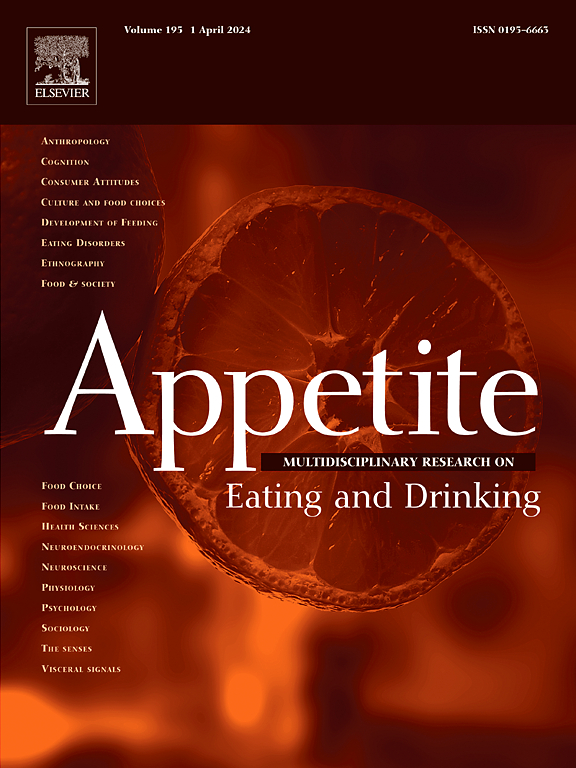厌恶和厌恶-对植物和动物源性食物的排斥的不同机制。
IF 4.6
2区 医学
Q1 BEHAVIORAL SCIENCES
引用次数: 0
摘要
人们可能因为厌恶(对不受欢迎的感官特性的情感反应)或厌恶(对食物所代表的概念的情感反应)而拒绝食物。厌恶可以进一步分为核心厌恶、动物提醒厌恶和道德厌恶,这些类型都可以影响食物排斥。先前的研究表明植物性和动物性食物的排斥机制不同。我们在一项在线研究中测试了这一点,其中包括拒绝肉类的样本(主要是素食者,n = 252)和接受肉类的样本(杂食者,n = 57)。参与者将他们拒绝食用的食物按照与厌恶(如对味道的反对)、一般厌恶(如食物的污染潜力)和特定厌恶亚型相关的标准进行评级。根据这些标准进行评分,为人们普遍不喜欢的蔬菜、肉类、普遍引起厌恶的食物和接受的食物(对照)创建了独特的反应概况。对反应谱的视觉检查、相关性和多维尺度分析都表明,植物性食物是基于厌恶而被拒绝的,而对美味肉类的拒绝反应与对人肉、粪便和狗肉(厌恶诱发物)的拒绝反应密切相关,两者都是基于厌恶而被拒绝的。研究表明,核心厌恶是主要的厌恶类型,动物提醒和道德厌恶有时也会出现。这项研究证实了植物性食物(因厌恶而拒绝)和肉类(因核心厌恶而拒绝)的不同排斥机制。这表明,人类必须适应不同的进化策略,以应对通过味觉检测到的植物毒素和肉类中无法检测到的病原体。这种适应可以在未来的干预措施中加以利用,以减少肉类消费或增加蔬菜摄入量。本文章由计算机程序翻译,如有差异,请以英文原文为准。
Disgust and distaste – Differential mechanisms for the rejection of plant- and animal-source foods
People may reject foods due to distaste (an affective reaction to undesirable sensory properties) or disgust (an emotive response to the idea of what a food represents). Disgust can further be classified into sub-types: core, animal-reminder, and moral disgust, all of which could influence food rejection. Prior research suggests different rejection mechanisms for plant and animal foods. We tested this in an online study in a meat-rejecting sample (mostly vegetarians, n = 252), and a meat-accepting sample (omnivores, n = 57). Participants rated foods they rejected for consumption on criteria related to distaste (e.g. objection to taste), general disgust (e.g. contamination potential of the food), and specific disgust sub-types. Ratings across these criteria created unique response profiles for commonly disliked vegetables, meats, universal disgust elicitors, and accepted food (control). Visual inspection of response profiles, correlations, and a multidimensional scaling analysis all revealed that plant foods were rejected based on distaste, whereas rejection responses to palatable meat closely matched responses to human meat, faeces, and dog meat (disgust elicitors), both rejected based on disgust. Inspecting disgust response profiles suggested that core disgust was the primary disgust type, with animal-reminder and moral disgust sometimes experienced in addition. This study confirms differential rejection mechanisms for plant-based foods (rejected via distaste) and meat (core disgust). This suggests different evolutionary strategies humans had to adapt to cope with plant toxins detectable through distaste and pathogens found in meat not detectable by taste. Such adaptations could be leveraged in future interventions to reduce meat consumption or increase vegetable intake.
求助全文
通过发布文献求助,成功后即可免费获取论文全文。
去求助
来源期刊

Appetite
医学-行为科学
CiteScore
9.10
自引率
11.10%
发文量
566
审稿时长
13.4 weeks
期刊介绍:
Appetite is an international research journal specializing in cultural, social, psychological, sensory and physiological influences on the selection and intake of foods and drinks. It covers normal and disordered eating and drinking and welcomes studies of both human and non-human animal behaviour toward food. Appetite publishes research reports, reviews and commentaries. Thematic special issues appear regularly. From time to time the journal carries abstracts from professional meetings. Submissions to Appetite are expected to be based primarily on observations directly related to the selection and intake of foods and drinks; papers that are primarily focused on topics such as nutrition or obesity will not be considered unless they specifically make a novel scientific contribution to the understanding of appetite in line with the journal's aims and scope.
 求助内容:
求助内容: 应助结果提醒方式:
应助结果提醒方式:


